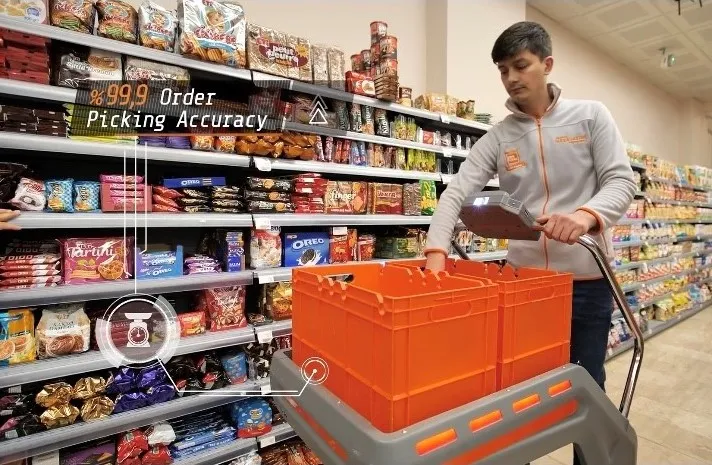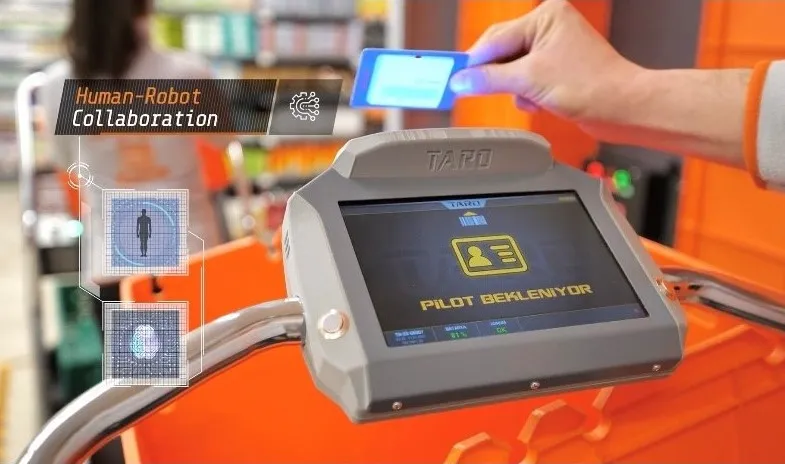Aisles Abroad is a regular feature that examines notable grocery initiatives outside the U.S.
When looking toward the future of online grocery fulfillment, experts often frame the debate in terms of manual or autonomous picking. Will retailers rely on workers picking orders from shelves? Or will they opt for more sophisticated — and costly — automated arrays like micro-fulfillment centers or robot-fueled warehouses?
Turkish grocer Migros believes there’s an in-between option that harnesses the strengths of both humans and bots to assemble orders efficiently. Over the past two years, the company has been steadily rolling out semi-autonomous carts that allow workers to collectively pick up to 20,000 orders a day from several dozen stores in nine cities across the country.
The proprietary Taro carts move autonomously through store backrooms stocked with up to 4,000 fast-moving SKUs, with workers perched on the back gathering items as they scoot through the aisles.
The cart operates like a souped-up, tech-laden version of the shopping companions used by millions of consumers every day. The carts stop in front of products that need to be gathered and then, on the shelves, indicators flash beneath the next item on the list. A screen attached to the cart shows workers which tote each product should go in, while product recognition software and weight sensors log each item as workers place them inside. If an item is placed in the wrong tote, a warning message blares on the tablet screen.
The carts harness the strengths of both human workers and automated machinery, said Mustafa Bartin, chief retail operations officer with Migros. Software helps the carts navigate the quickest, most efficient path through the fulfillment space, while workers are able to quickly grab — grabbing is a skill robotics experts have struggled to replicate, he noted — each product off the shelf.
Workers can fill two orders at a time, and it takes around 13 seconds to pick each product using the Taro cart.
“You have to keep people in the equation. The extra capex of full automation is not worth it,” Bartin said.

‘Not rocket science’
The high cost of fully automated systems helped drive the invention of the Taro cart. Migros began offering online shopping in 1997, but 20 years later the cost of picking products off shelves was cutting too deeply into its profits. So the company began assessing various options. Bartin and his team sized up MFCs from tech firms like Autostore as well as customer fulfillment centers (CFCs) from Ocado, and found the costs to be too high. He recalled a meeting with Ocado CEO Tim Steiner at that company’s headquarters that left him with sticker shock.
“Turkey is not a rich country,” Bartin said.
Fully automated options also weren’t the right fit for Migros, which sees the majority of its demand in same-day delivery service. A large CFC in Istanbul wouldn’t be able to deliver a really high volume of same-day orders, Bartin said, while most MFCs were too big to fit inside the company’s stores, more than half of which are 6,000 square feet or less in size.
So Bartin turned to a friend who was an expert in robotics and asked him to design a solution.
At an executive meeting held at an ice cream shop near company headquarters, the friend began sketching out on a piece of paper what would eventually become the Taro cart.
“The only thing I asked him was just to make something which is not rocket science, and that’s not fully automated,’ Bartin said.
Within three months, Migros had a Taro prototype built, and by July 2020, had its first carts fulfilling orders inside backrooms, or “mini dark stores” as Bartin refers to them, stocked with a selection of fast-moving goods. The company began quickly rolling out the carts and fulfillment systems to stores to meet the glut of pandemic demand. Currently, Migros operates the carts in the back of 53 stores and plans to expand them to as many as 150 locations.
That’s a small fraction of the nearly 3,000 stores Migros operates throughout Turkey — but many of those don’t have backrooms that are big enough for the carts, which require at least 2,000 square feet of space to operate effectively, Bartin said.
Each cart has around 20 hours of battery life, meaning it can run an entire workday before needing a charge. The carts run throughout the day in Migros’ mini dark stores, pausing for a short break in the early afternoon and at night for workers to restock shelves. For safety reasons, the carts only operate in dedicated picking spaces where shoppers and other workers aren’t walking around, Bartin said.
Migros also operates an ultrafast delivery service that’s helped it keep pace with speedy rivals like Getir and Delivery Hero. The fulfillment spaces for that service are small — too small for the semi-automated carts — but they still use the same Taro pick-to-light and order recognition technology, Bartin said.

U.S. grocers come calling
Bartin showed off the Taro carts during the Groceryshop show in Las Vegas in September and at another recent trade show in London. Since then, he’s fielded inquiries from several grocery chains abroad. Recently, he hosted the head of e-commerce for Meijer, who rode on the back of a Taro cart and picked products.
Like Migros, U.S. grocers are looking to lower the cost of picking products across delivery and pickup services, especially in high-demand markets. Unlike Migros, their comparatively large stores tend to have more space for dedicated in-store fulfillment areas. As the pandemic drove up e-commerce demand in recent years, some grocers began carving out these picking areas in their backrooms and even on their retail floors.
Could U.S. grocers boost their dedicated fulfillment areas using semi-automated carts like the ones Migros makes?
Jason Soar, a partner in the e-commerce division of consulting firm The Partnering Group and a former e-commerce executive with U.K. grocer Sainsbury’s, did an initial evaluation of the Taro cart earlier this year. Soar said he questions whether the technology can help workers pick faster and more accurately than they could using the non-automated, less costly “zone-based” in-store picking system that’s become popular with grocers in the U.K. and Europe, and which he advises U.S. grocers to invest in. That system assigns workers specific store sections to pick products, which then get combined into full orders, allowing retailers to efficiently collect multiple orders at a time.
Soar noted that it’s tricky to add robotics to order-picking areas since no two orders are the same and assembling them can be highly complex. In his view, the Taro carts would work best inside a “fast pick zone” that operates in tandem with a micro-fulfillment system, where workers fulfill fast-moving goods that aren’t housed inside the automation.
“It’s a closed environment, that is small, structured and clear of clutter” and contains a limited assortment of goods, Soar said in an email.
Bartin, meanwhile, said at Groceryshop that the Taro carts have reduced picking costs for Migros stores by a third and have an order picking accuracy rate that’s over 99%. He said that setting up a Taro system, which includes two carts, the pick-to-light system and assorted hardware and software, costs around $250,000. A typical installation takes between two and three days.
As e-commerce demand continues to grow — albeit at a slower pace than what grocers saw during the height of the pandemic — there are signs that automation in some form will be key to processing high volumes of orders efficiently. Walmart recently acquired MFC maker Alert Innovations, while Kroger has continued to build out its network of automated fulfillment centers focused on next-day delivery service. Albertsons has opened several MFCs in partnership with Takeoff Technologies, including a site that just opened in a Safeway store near downtown Seattle.
But fully automated systems have so far proven to be complex and costly to operate. That’s given rise to middle-ground options like zone picking, dark stores and vertical storage systems that are less expensive to start up and operate. Semi-autonomous carts could join those ranks, though they have yet to be fully tested outside of Migros stores.
In addition to finding simple, effective fulfillment technology, retailers need to continue to find ways to use their most valuable existing assets to fulfill orders, Bartin noted.
“You have to use your stores,” he said. “The store is the heart of your business.”





















